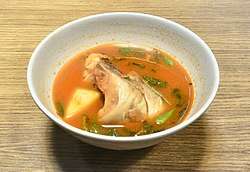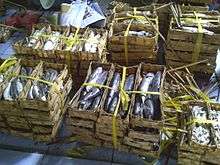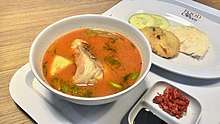Pindang
 Pindang patin, pangasius fish in pindang soup | |
| Place of origin | Indonesia[1] |
|---|---|
| Region or state | Palembang, South Sumatra[1] |
| Created by | Indonesian cuisine |
| Main ingredients | fish cooked in spices including tamarind juice, garlic, shallot, ginger, turmeric, lemongrass, galangal, chili pepper, Indonesian bayleaf, citrus leaf, shrimp paste, palm sugar and salt. |
Pindang is a cooking method of boiling ingredients in salt and certain spices, usually employed to cook fish or egg. Pindang has preservative property, which used to extend the shelf life of fish. The technique is native to Java and Sumatra.[2] The Indonesian dictionary describes pindang as "salted and seasoned fish, and then smoked or boiled until dry for preservation."[3]
The term also could refer to a specific freshly sour and spicy fish soup which uses sour-tasting spices, usually tamarind. Although pindang method and dishes could be found all across Indonesia, the pindang dish is associated especially to Palembang, where pindang patin (Pangasius fish pindang) is its specialty.[1]
As a dish
Pindang as a dish refer to a certain sour and spicy fish soup. Freshwater fish such as ikan patin (Pangasius sp.), catfish, carp or gourami are popularly used to cook pindang. However, seafood such as red snapper, milkfish, mackerel, tuna or shrimp can be cooked as pindang too. The cleaned fish flesh is boiled in water mixed in spices, including tamarind juice, garlic, shallot, ginger, turmeric, lemongrass, galangal, chili pepper, daun salam (Indonesian bayleaf), citrus leaf, shrimp paste, palm sugar and salt. The soup usually also contains pieces of chili pepper, tomato, cucumber, lemon basil and pineapple. This soupy dish has a pronounced sourness with a hint of mild sweetness and light hot spicyness.[1]
As preservation method

_in_de_visinzoutingsloods_te_Blimbing_Oost_Java_TMnr_10014130.jpg)
The term pindang refer to the cooking process of boiling the ingredients in salt together with certain spices that contains tannin,[2] usually soy sauce, shallot skin, guava leaves, teak leaves, tea or other spices common in Southeast Asia. This gives the food a yellowish to brown color and lasts longer compared to plainly boiled fish or eggs, thus pindang is an Indonesian traditional method to preserve food, usually employed for fish and eggs.[2] The technique is native to Java and Sumatra. In Indonesia, various preserved pindang fish are available in traditional markets. Common fish being processed as pindang are tongkol (mackerel tuna), bandeng (milkfish), and kembung (mackerel).
Compared to salted fish, pindang uses fewer salt, thus the taste is not as salty as salted fish. Other preserving method common in Indonesian cuisine includes asin (salted) or cured and dried in salt, and dendeng which is cured and dried in sugar, acar (pickling), and also asap (smoked).
Variants

Pindang variants can be differentiated according to the kind of fish species being used, or according to specific regional recipe which uses different ingredients and spices combination. Pindang recipes can be found in various cooking traditions of Indonesia; from Javanese, Betawi to Malay South Sumatran cuisine. Nevertheless, pindang recipes shows its exceptional diversity in South Sumatra.
- Pindang meranjat: the most hot and spicy South Sumatran pindang variant from Meranjat village, Ogan Komering Ilir Regency. Uses iwak salai (smoked fish) made from catfish, patin, baung, or lais fish.[4]
- Pindang musi rawas: Sour and fresh pindang from Musi Rawas, which unlike other variants, it uses mashed tomato instead of tamarind as souring agent.[4]
- Pindang palembang or pindang patin: Pangasius pindang, specialty of Palembang.[1]
- Pindang pegagan: Pindang variant uses turmeric and chili pepper. Its soup is light and not oily, since the spices are boiled directly, and not stir fried in palm oil.[4]
- Pindang sekayu: Sweet tasting fish pindang from Sekayu, Musi Banyuasin, using sweet soy sauce.[4]
- Pindang serani: Pindang specialty of Jepara, Central Java. Could be made from various kind of seafood, but the popular one is milkfish.[5]
- Pindang tongkol: Pindang variant uses pindang processed mackerel tuna.
- Pindang telur: eggs cooked in pindang process.
See also
- Asam pedas, similar dish of Minang and Malay origin
- Tom yum, similar dish from Thailand
References
- 1 2 3 4 5 "Pindang Patin Palembang" (in Indonesian).
- 1 2 3 "Pengolahan Jamur Komersial, Jahe Instan, Ikan Asap, Telur Pindang" (PDF) (in Indonesian). Jurusan Teknologi Pangan dan Gizi-IPB. pp. 103–104. Bogor. Archived from the original (PDF) on 2014-04-13.
- ↑ "Pindang". Kamus Besar Bahasa Indonesia (in Indonesian).
pindang/pin·dang/ n ikan yang digarami dan dibumbui kemudian diasapi atau direbus sampai kering agar dapat tahan lama
- 1 2 3 4 "Lima Pindang Khas Sumatera Selatan". Laskar Wong Kito (in Indonesian).
- ↑ "Pindang Serani khas Jepara". Cookpad (in Indonesian).
External links
- Pindang Patin Palembang (Cookpad)
- Ikan Pindang, Indonesian Fish Brine Recipe (Indonesia Eats)